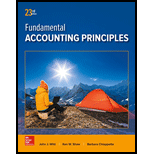
Concept explainers
Concept Introduction:
Payroll-
Payroll is simply an agreement between employer and employee which is related to the compensations to the employee for any services provided by them.
Requirement-
To record:
Answer to Problem 8E
Solution:
| S. No. | Accounts title and Explanation | Debit ($) | Credit ($) |
| 1 | Sales Salaries expense | 200,000 | |
| Office Salaries expense | 160,000 | ||
| Social security taxes payable | 22,320 | ||
| Medicare tax payable | 5,220 | ||
| Employee federal income taxes payable | 90,000 | ||
| Employee state income taxes payable | 20,000 | ||
| Employee medical insurance payable | 2,800 | ||
| Employee life insurance payable | 1,600 | ||
| Employee union dues payable | 1,000 | ||
| Salaries payable | 217,060 | ||
| (To record accrual payroll including employee deductions) | |||
| 2 | Salaries payable | 217,060 | |
| Cash | 217,060 | ||
| (To record the cash payment of salaries) | |||
| 3 | Payroll taxes expense | 37,140 | |
| Social security taxes payable | 22,320 | ||
| Medicare tax payable | 5,220 | ||
| State |
2,700 | ||
| Federal unemployment taxes payable | 300 | ||
| Employee medical insurance payable | 4,200 | ||
| Employee life insurance payable | 2,400 | ||
| (To record the accrued payrolls) | |||
| 4 | Social security taxes payable | 44,640 | |
| Medicare tax payable | 10,440 | ||
| Employee federal income taxes payable | 90,000 | ||
| Employee state income taxes payable | 20,000 | ||
| Employee medical insurance payable | 7,000 | ||
| Employee life insurance payable | 4,000 | ||
| Employee union dues payable | 1,000 | ||
| Federal unemployment taxes payable | 2,700 | ||
| Employee medical insurance payable | 300 | ||
| Cash | 180,080 | ||
| (To record the payment of all liabilities) |
Explanation of Solution
1. Given :
• Sales salaries expense - $200,000
• Office salaries expense - $160,000
• Social security taxes payable - $22,320
• Medicare tax payable - $5,220
• Employee federal income taxes payable - $90,000
• Employee state income taxes payable - $20,000
• Employee union dues payable - $1,000
Calculation of amount of premium paid by the employee and employer-
| Particulars | Total Premium (A) | % paid by Employees | Premium paid by employees (B) | Premium paid by employers (A-B) |
| Employee medical insurance payable | $7,000 | 40% | $2,800 | $4,200 |
| Employee life insurance payable | $4,000 | 40% | $1,600 | $2,400 |
Salaries payable is the balancing figure which is calculated as follows-
2. In this transaction company has made cash payment of salaries payable, so Salaries payable is debited and cash is credited.
3. Calculation of State unemployment taxes payable-
Calculation of Federal unemployment taxes payable –
4. In this transaction, all the liabilities are being paid, so all the liabilities will be debited and payment is made with the cash so the cash will be credited.
Thus, all the entries related to payroll have been prepared.
Want to see more full solutions like this?
Chapter 11 Solutions
Fundamental Accounting Principles
- Financial Accountingarrow_forwardSub. general Account. Answer. Asap.arrow_forwardOn July 1, 2022, Burrough Company acquired 136,000 of the outstanding shares of Carter Company for $15 per share. This acquisition gave Burrough a 25 percent ownership of Carter and allowed Burrough to significantly influence the investee's decisions. As of July 1, 2022, the investee had assets with a book value of $7 million and liabilities of $456,800. At the time, Carter held equipment appraised at $319,200 more than book value; it was considered to have a seven-year remaining life with no salvage value. Carter also held a copyright with a five-year remaining life on its books that was undervalued by $980,000. Any remaining excess cost was attributable to an indefinite-lived trademark. Depreciation and amortization are computed using the straight-line method. Burrough applies the equity method for its investment in Carter. Carter's policy is to declare and pay a $1 per share cash dividend every April 1 and October 1. Carter's income, earned evenly throughout each year, was $579,000…arrow_forward

 AccountingAccountingISBN:9781337272094Author:WARREN, Carl S., Reeve, James M., Duchac, Jonathan E.Publisher:Cengage Learning,
AccountingAccountingISBN:9781337272094Author:WARREN, Carl S., Reeve, James M., Duchac, Jonathan E.Publisher:Cengage Learning, Accounting Information SystemsAccountingISBN:9781337619202Author:Hall, James A.Publisher:Cengage Learning,
Accounting Information SystemsAccountingISBN:9781337619202Author:Hall, James A.Publisher:Cengage Learning, Horngren's Cost Accounting: A Managerial Emphasis...AccountingISBN:9780134475585Author:Srikant M. Datar, Madhav V. RajanPublisher:PEARSON
Horngren's Cost Accounting: A Managerial Emphasis...AccountingISBN:9780134475585Author:Srikant M. Datar, Madhav V. RajanPublisher:PEARSON Intermediate AccountingAccountingISBN:9781259722660Author:J. David Spiceland, Mark W. Nelson, Wayne M ThomasPublisher:McGraw-Hill Education
Intermediate AccountingAccountingISBN:9781259722660Author:J. David Spiceland, Mark W. Nelson, Wayne M ThomasPublisher:McGraw-Hill Education Financial and Managerial AccountingAccountingISBN:9781259726705Author:John J Wild, Ken W. Shaw, Barbara Chiappetta Fundamental Accounting PrinciplesPublisher:McGraw-Hill Education
Financial and Managerial AccountingAccountingISBN:9781259726705Author:John J Wild, Ken W. Shaw, Barbara Chiappetta Fundamental Accounting PrinciplesPublisher:McGraw-Hill Education





